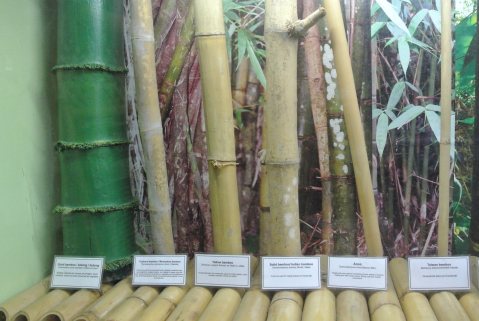In my last blog, I was able to provide you a very short insight into Philippine’s bamboo species including the most common native types of bamboos such as clumping bamboos, bamboo’s maintenance, and propagation.I also highlighted that bamboos plays a major role in forest recovery as part of the enhanced National Greening Program (eNGP). Though bamboo can play a significant role in forest recovery, it’s role reaches much further than that. Bamboo can be turned into an actual value product, with some value products being more complicated to produce than others.
Near the forestry department in Los Banos is also a beautiful and small museum located. This museum demonstrates different aspects of Philippine’s rich biodiversity, forest products and natural habitats of many in the forest residing animal species. One section in the museum is devoted towards bamboo and in specific towards the usages of different bamboos, bamboo value products and the overall importance of bamboo in the Philippines.
Can you zoom into the images below and read some of the descriptions for each bamboo pole that is displayed? Each description lists the name of the bamboo species and its common usages. An example is the big and green colored bamboo on the left side which is known as Giant Bamboo. It is commonly used as building material for houses and bridges, liquid containers as well as shoots. Other bamboos such as the Yellow Bamboo is more likely used as ornamental bamboo or for fine handicrafts.
Depending on the species, the usage of bamboo for a value product varies. Let’s look at the image to the right. In comparison to the images of the bamboos that I posted previously, these are very thin bamboos. Try zooming into the image. You will see that these bamboos are very thin with very long internodes. The bamboo’s flexibility, strength, light weight, and long internodes makes it therefore ideal for fishing. These type of bamboo ”bars” do not only grow sustainably but serve as a great opportunity for communities with low income and for communities who depend on fishing for livelihood. In addition, this type of ”fishing gear” can easily be replaced while reducing any footprint since the bamboo degrades naturally.
There are of course more bamboo products with some Philippine bamboo products being displayed at the UPLB environmental department’s Bamboo and Rattan showroom. Not that the items below are only bamboo products. Since this blog is about bamboo, I have purposely left out the rattan showroom. To produce more complicated products such as bamboo fiber, more knowledge and technologies need to be shared with the Philippines. China for instance has the knowledge for complex bamboo textile production. To fully develop different bamboo sectors, it is therefore important for countries to collaborate.
As you may have clicked through the images, some products may seem simpler to produce than others. Based on my experience, value products become more easily to produce when most parts of the bamboo can remain as they are naturally such as bamboo cups or straws. Other products require advanced knowledge or technologies. Below you can find further bamboo products that I encountered as I traveled through the Philippines. For some products, the bamboo poles can directly be seen but for other products, more knowledge is required such as for the building of the bamboo housing. Bamboo housing, if built adequately can be earthquake resistant, an especially important aspect for the Philippines since earthquakes occur frequently.
Multiple bamboo species can be used for the production of multiple products. At the same time we can make use of the residue that occurs during production, or bamboo that is not useful for production. Instead of throwing these residues or unusual bamboos away, they can be produced into a new product, namely charcoal. It is being produced by sorting, chopping and drying the residues. After drying, the residues will be carbonized, grinded, mixed and briquetted. The final step includes the drying of the briquettes. Each briquet (see image below) provides enough energy for one-hour cooking. This is really great, considering the global amount of people without adequate energy supply (World Energy Outlook, 2016)
For my visit at the environmental department, Digno Garcia was kind and had me participate in the charcoal production. It is also not as easy as it may looks like and I am thankful for the help I was given. Please notice that not necessarily residue or unuseful poles are needed to produce the charcoal. Any poles can be used and it is suggested as a result of the bamboo’s fast and sustainable growth. At the same time, using residue provides a great opportunity in waste up-cycling. In the case of this specific charcoal production, mixed plant residues are used.
Source: https://annjoest.com/a-few-uses-for-bamboo-and-its-importance-in-the-philippines/


Recent Comments